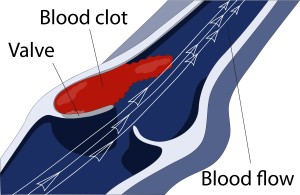Are you over 60 years old? Are you pregnant or had a baby in the last six weeks? A smoker or overweight? If you answered yes to any of these questions, you are at risk for Deep Vein Thrombosis! The National Heart, Lung, and Blood Institute has a list of risk factors for Deep Vein Thrombosis.
Treatment includes medicines to ease pain and inflammation, break up clots and keep new clots from forming. Keeping the affected area raised and applying moist heat can also help. If you are taking a long car or plane trip, take a break, walk or stretch your legs and drink plenty of liquids.
Know the Symptoms to Save Your Life
About half of people with DVT have no symptoms at all. The following are the most common symptoms of DVT that occur in the affected part of the body:
- Swelling
- Pain
- Tenderness
- Redness of the skin
If you have any of these symptoms, see your doctor as soon as possible. You can have a PE without any symptoms of a DVT. Signs and symptoms of a PE include:

An estimated 350,000–900,000 persons develop incident VTE yearly. The CDC states that approximately 100,000 died of venous thromboembolism (VTE}.
- Difficulty breathing
- Faster than normal or irregular heartbeat
- Anxiety
- Coughing up blood
- Very low blood pressure, lightheadedness, or fainting
If you have any of these symptoms, seek medical help immediately. Move around as soon as possible after having been on bed rest, such as after surgery, illness, or injury.
Four Steps to Protect Yourself
The following four tips can help prevent blood clots:
- Move around as soon as possible after having been on bed rest, such as after surgery, illness, or injury
- If you’re at risk for blood clots, talk to your doctor about:
- Graduated compression stockings (sometimes called “medical compression stockings”)
- Medication (called anticoagulants) to prevent blood clots.
- When sitting for long periods of time, such as when traveling for more than four hours:
- Get up and walk around every 2 to 3 hours.
- Exercise your legs while you’re sitting by:
- Raising and lowering your heels while keeping your toes on the floor
- Raising and lowering your toes while keeping your heels on the floor
- Tightening and releasing your leg muscles
- Wear loose-fitting clothes.
- You can reduce your risk by maintaining a healthy weight, being active, and following your doctor’s recommendations based on your individual risk factors.
Jay Harold urges you to be aware of Deep Vein Thrombosis and Pulmonary Embolism. Prevention is far better than treatment with drugs or medical compression stockings. Learn more by visiting the MedlinePlus website or CDC’s site on Deep Vein Thrombosis. Another great resource is the National Library of Medicine’s website.
Play the free “Slow Roll Through Civil Rights” Game found on the Jay Harold website. Enjoyed this post? Share it and read more here.





